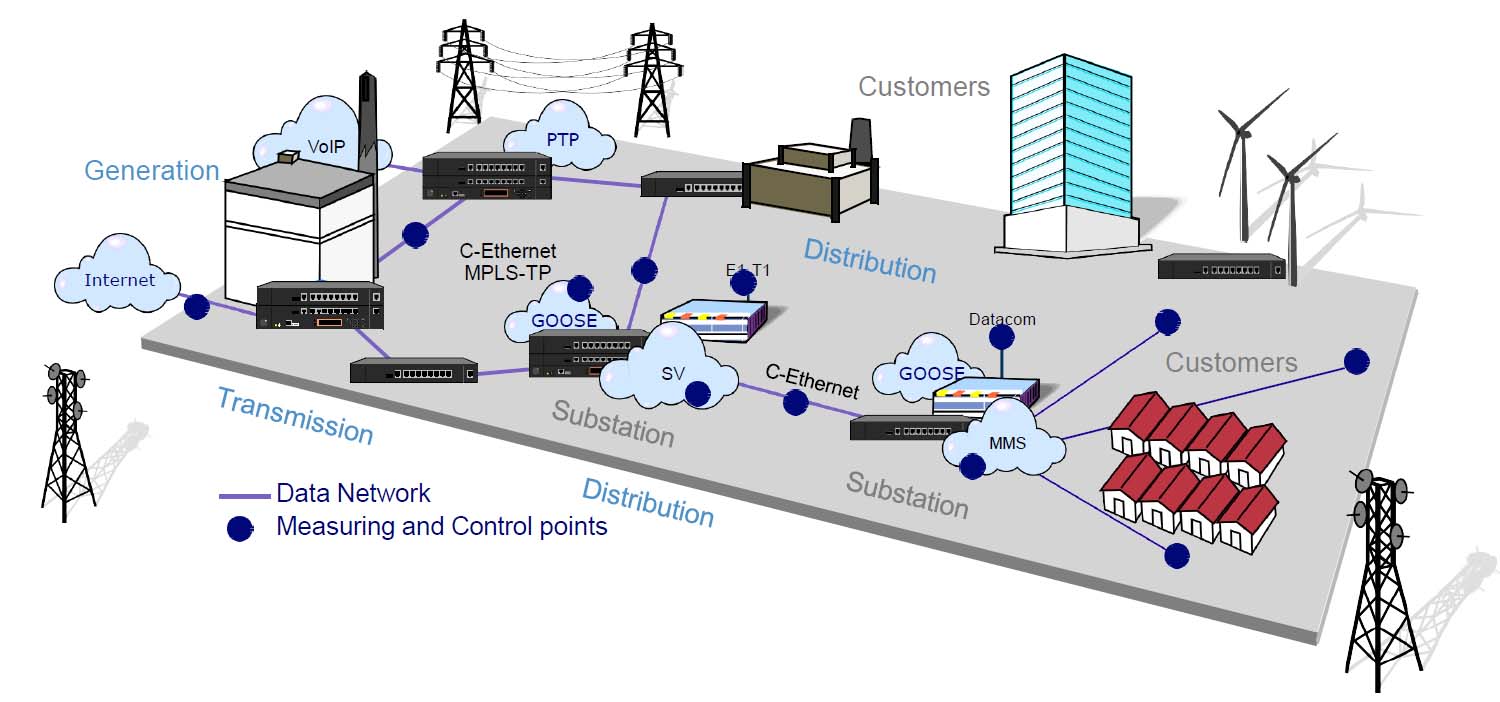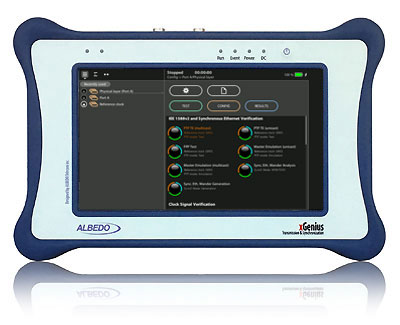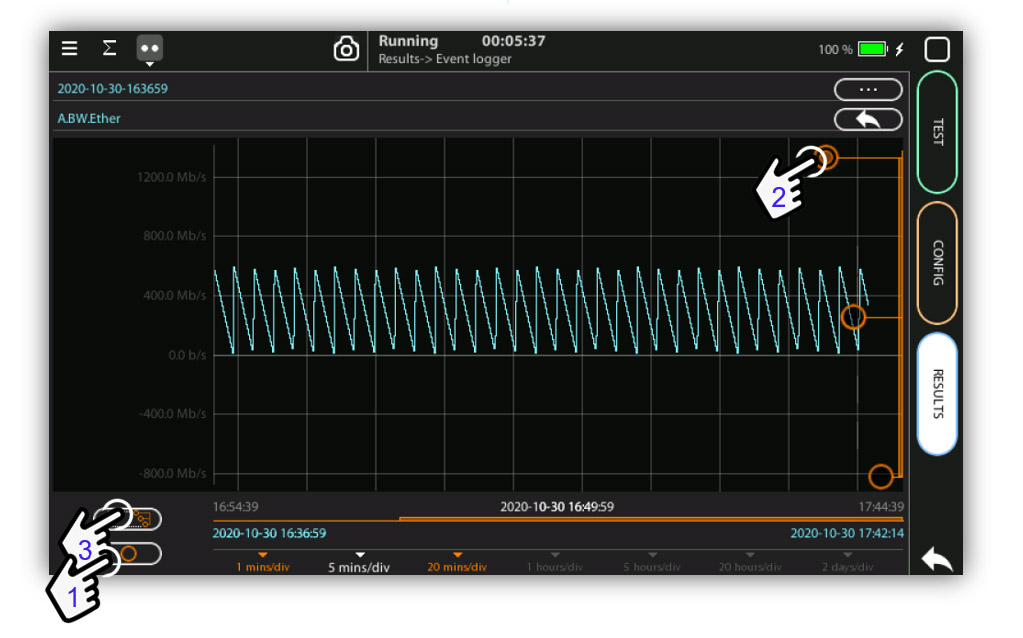Ethernet traffic test in Utilities
The use of Ethernet, MPLS, and IEC-61850 in power grid networks enables the deployment of robust and scalable infrastructures, as well as the use of standard protocols that facilitate interoperability, control, and service efficiency.
MIAMI NOV.21.2023
Ethernet Adoption in the Power Industry
The convergence of communications networks to Ethernet technology is a process that occurred in local area networks (LANs) in the 1980s, in wide area networks (WANs) at the end of 1990s and in mobile/wireless networks in 2000s, and is currently occurring in utility networks. Ethernet-based architectures can improve the performance of legacy SONET/SDH and IRIG-B-based solutions through the adoption of Multiprotocol Label Switching (MPLS) technology in the WAN, which adds connection-oriented features to improve network performance, support traffic engineering, and facilitate the deployment of advanced network services, while at the substation the adoption of IEC 61850 provides a robust, scalable and standardized architecture. For those services and fault-tolerant architectures designed to deliver mission-critical services, Resilient Packet Ring (RPR) can improve resilience to levels approaching SDH.

Fig 1. Network convergence is one of the drivers for utilities.
In other words, the adoption of Ethernet is underway across the utility industry. Much of the infrastructure is being integrated, and many TDM, datacom, and serial data services are being migrated from circuit- and circuit-oriented networks to packet-oriented networks.
Ethernet Benefits
Ethernet is an industry-standard network protocol, which means that utilities can take advantage of a vast ecosystem of commercially available components and solutions that foster interoperability and competition among vendors and has a number of important benefits:
- Interoperability: Ethernet ensures interoperability between devices from different vendors, simplifying the integration of diverse components into the power grid.
- Bit rate: Ethernet provides high bit rates for data transmission, which is critical for managing the increasing amount of data generated in power systems.
- Real-time: Enabling faster and real-time communications for monitoring and control, especially over the WAN, which requires increasing amounts of bandwidth.
- Scalability: Ethernet networks can scale easily, allowing utilities to expand their networks by adding more devices without significant infrastructure changes, making it adaptable to the evolving needs of the power grid.
- Reliability: Ethernet has evolved to provide high reliability and fault tolerance. Redundancy features, such as RPR, ensure that communications remain robust even in the presence of failures.
- Cost: Ethernet is becoming less expensive due to its widespread use and mass production. This makes it an economical choice for utilities, especially when compared to proprietary alternatives.
The conclusion is that Ethernet, and in particular MPLS-TP and IEC 61850 implementations, is a very attractive solution for utilities to modernize and optimize their systems, and there are good reasons to justify the investment.

Fig 2. All over Ethernet: MPLS on the WAN and IEC-61850 at the substation.
MPLS in the WAN
Designed for transport networks, MPLS-TP combines the flexibility and scalability of MPLS with features tailored to the needs of industries such as utilities. And for good reasons:
- Predictable: ensures consistent and reliable performance, which is critical for utility networks running mission-critical applications with strict timing and data delivery requirements.
- Fault Tolerant: Includes fault detection, protection, and recovery mechanisms to ensure continuous operation when reliability is critical.
- Traffic Engineering: MPLS-TP enables the optimization of data flow by prioritizing different types of traffic used in the utility.
- OAM: Provides network monitoring, fault detection, and troubleshooting tools to maintain network reliability.
- Interoperability: MPLS-TP enables the integration of new equipment into legacy networks, this is important as utilities tend to be conservative with established infrastructures.
- Scalability: MPLS-TP provides the scalability that enables utilities to expand their networks and meet increasing traffic and communications demands as power systems evolve.
MPLS-TP’ tailored features make it well suited to meet the needs of utilities, providing a robust and efficient infrastructure.

Fig 3. Migration of Power grid communications to Ethernet.
IEC 61850 at the Substations
IEC 61850 is an international standard based on Ethernet that defines communication protocols for substation automation systems to ensure that devices from different manufacturers can communicate seamlessly within a substation.
- Improved interoperability: IEC 61850 standardizes communication between different types of intelligent electronic devices (IEDs) in substations.
- Data model: IEC 61850 defines a common data model for power systems, enabling consistent representation and exchange of information.
- Efficient engineering: The standard includes specifications for the engineering process, making the configuration and commissioning of substation automation systems more efficient.
- Substation Automation: IEC 61850 supports advanced substation automation features such as intelligent device integration, seamless communication, and the ability to implement advanced protection and control schemes.
In other words, the combination of Ethernet and IEC 61850 provides utilities with a robust, scalable and standardized communication infrastructure that is essential for the efficient and reliable operation of modern power systems.

Fig 4. Tester designed to turn-up Ethernet networks.
Traffic Test with xGenius
The purpose of this test is to show how to set up the tester to generate and receive real traffic with specific frames, bit rates and events. With a few modifications, it is possible to evaluate other traffic parameters such as throughput, latency, frame loss rate, etc. The document also describes specific formats for tracking and reporting the results of this test.

Fig 5. Two Configurations to perform the traffic test with one or two testers.
xGenius
xGenius provides in-depth insight into the design, installation, maintenance, troubleshooting and engineering of Smart Grid communications infrastructures. The unit can test Ethernet/IP, PTP, GbE, IRIG-B, T1/E1, G703, C37.94 and GOOSE, SV and MMS protocols. One-way delay testing, supported by GPS, is available on all interfaces. Zeus has a set of programmable filters to capture live traffic at wire speed. You can now analyse GOOSE, SV, MMS and other protocols to decode and store them in PCAP format or calculate propagation delay from local or remote substations.

Fig 6. Chronogram with the results of the test and evolution.

